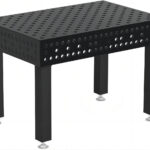In today's competitive metal fabrication industry, having the right equipment is crucial for efficiency, precision, and safety. Among the most vital tools in any metalworker's arsenal is the welding table. A robust welding table serves as the foundation for numerous fabrication tasks, from simple repairs to complex assemblies. This article explores the features, benefits, and practical applications of various types of welding tables, helping you choose the perfect model for your needs.
1. The Essential Features of a Top-Quality Welding Table
A superior welding table, often referred to as a fabrication table, combines durability, functionality, and adaptability. The top plate of the table is usually made from thick, high-strength steel that can withstand high temperatures and resist warping. For precision tasks, tables may come equipped with a grid of holes for clamping and positioning workpieces securely. Options like the welding fixturing table and the welding jig table also offer modular setups, allowing for customizable workspace configurations that enhance workflow efficiency.
2. Types of Welding Tables and Their Applications
- Metal Welding Tables: Constructed from heavy-duty steel, these tables are designed for handling the rigors of daily welding tasks. They are ideal for projects that require high thermal and structural integrity.
- Aluminum Welding Tables: Lighter than steel tables, these are perfect for workshops where mobility of equipment is necessary. Aluminum tables are resistant to rust, making them suitable for environments with high humidity.
- Welding Fabrication Tables: These are versatile units designed to accommodate a variety of metalworking activities, including cutting, grinding, and assembly in addition to welding.
3. Choosing the Best Welding Table for Your Needs
Selecting the right table involves understanding the specific requirements of your projects. Consider the following factors:
- Size and Scale of Projects: Larger tables provide more workspace, essential for handling big or multiple components simultaneously.
- Material Compatibility: Ensure the table material suits the welding techniques and metals you typically work with.
- Additional Features: Look for tables with adjustable legs, tool storage, and easy-to-clean surfaces to enhance usability and maintenance.
4. Practical Use Cases of Welding Tables in Industry
Welding tables are indispensable in industries ranging from automotive repair to structural engineering. For instance, in automotive workshops, a sturdy weld table top can support parts like exhaust manifolds during welding or assembly. In construction, metal welding tables are used for fabricating metal beams and frames, which require precision and strength.
5. Why Choose Our Welding Tables?
At KT-Foundry, we offer a comprehensive range of welding tables that cater to both general and specialized metalworking applications. Our tables are sourced from leading welding table manufacturers, ensuring quality and durability. With options for customization and accessories like clamps and hooks, our tables are designed to enhance your welding efficiency and accuracy.
To explore our full range of welding tables and find the perfect fit for your fabrication needs, visit our website at kt-foundry. Our expert team is ready to assist you with product choices and provide detailed information to ensure you get the most out of your investment.






